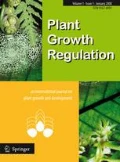Abstract
The growth of mustard was increased significantly when treated with up to 80 kg N ha−1 (N80). Spraying with (2-chloroethyl) trimethylammoniumchloride (chlormequat chloride) increased seed yield and seed protein content. Spraying nitrogen fertilized plots with chlormequat chloride, increased leaf area, leaf area ratio, leaf area duration, number of siliquae plant−1, number of seeds siliqua−1 and length of siliqua. Reducing, non-reducing and total sugars in the leaves at 80 days after sowing were also affected significantly. Chlorophyll ‘a’, ‘b’ and total chlorophyll were little affected. The number of siliquae plant−1 was highly correlated with seed yield in both the seasons of experimentation. The correlation coefficient value (γ) was 0.586 in 1982/83 and 0.912 in 1983/84.
The total accumulation of nutrients, i.e. nitrogen, phosphorus and potassium in seed and straw was significantly affected by N80 × chlormequat chloride interaction.
Similar content being viewed by others
References
Andreeva TF, Strongonova LE, Voevudskaya SYu, Maevskaya SN and Cherkanova NN (1989) Effect of increased CO2 concentration on photosynthesis, carbohydrate and nitrogen metabolism and growth processes of the mustard plant. Fiziol Rast 36: 40–48
Balcerek W (1983) Top application of nitrogen and chlorocholine chloride (CCC) to crops of winter turnip rape (Brassica rapa L. Var. Sylvestris cv. Briggs) grown for seed. [Abstract] In: 6th International Rapeseed Conference, Paris, France (1983) 318 [en] Institute of Soil and Plant Cultivation, 71–434 Szczecin, Poland
Bertramson BR (1942) Phosphorus analysis of plant materials. Plant Physiol 17: 447–454
Bidwell RGS (1979) Plant Physiology. 2nd edn. New York: Macmillan
Evans GC (1972) The Quantitative Analysis of Plant Growth. Oxford: Blackwell Scientific Publication
Hedden P, Temple-Smith KE and Rademacher W (1988) Regulating Plant Growth: Mode of Action of BAS 111...in Oilseed Rape. In: Institute of Arable Crops Research Report. p 88
Humphries EC (1956) Mineral component and ash analysis. In: Peach K and Tracey M V, ed. Modern Methods of Plant Analysis. Berlin, Göttingen and Heidelberg: Springer-Verlag, p 468
Humphreys EC (1963) Effect of (2-chloroethyl) trimethyl ammonium chloride on plant growth, leaf area and net assimilation rate. Ann Bot (London) 27: 517–532
Jackson ML (1967) Vanadomolybdo-Phosphoric yellow methods using Bartons reagent. In: Soil Chemical Analysis. New Delhi: Prentice Hall of India Pvt Ltd. p 485
Jesmanowicz A (1973) Effect of nitrogen and Cycocel applications on maize (Zea mays) yield. Pamiethik Pullowski 28: 123–130
Loomis WE and Shull CA (1937) Methods in Plant Physiology. New York and London: MacGraw Hill Book Co. Inc
Morton AJ and Watson DJ (1948) A physiological study of leaf growth. Ann Bot (London) 12: 281–310
Pandey RB, Khan MI, Gupta SK and Arora SK (1974) Effect of CCC on growth, yield and chemical composition of raya (Brassica juncea L.). Biochem and Physiol der Pflanzen 165: 283–289
Panse VG and Sukhatme PV (1985) Statistical method for agricultural workers. Edn. IV. New Delhi: Indian Council of Agricultural Research (ICAR)
Radford PJ (1967) Growth analysis formulae—their use and abuse. Crop Sci 7: 171–175
Sankaran A (1966) A Laboratory Manual for Agricultural Chemistry of Oil Estimation by Soxhlet Method. New York: Asia Publishing House. p 258.
Scarisbrick DH, Daniels RW and Rawi ABN (1982) The effect of 2-chloroethyltrimethyl-ammonium chloride on the yield and yield components of oilseed rape. J Agri Sci 99: 453–455
Somogyi N (1946) A micro method for detemination of sugar in plants. J Biol Chem, 160–161
Triboi-Biondel AM (1988) Variations in leaf area index in winter rape: Effects on yield. Centre Technique Interprofessonal des Oleagineux Metropolitains (CETIOM) No. 103: 106–110
Watson DJ (1952) The physiological basis of variation in yield. Adv Agron 4: 101–145
Witham FH, Blaydes DF and Devlin RM (1971) Chlorophyll absorption spectrum and quantitative determination. In: Experiments in Plant Physiology. New York: Van Nostrand Reinhold Company. pp 55–56
Author information
Authors and Affiliations
Rights and permissions
About this article
Cite this article
Prasad, S., Shukla, D.N. Effect of nitrogen and chlormequat chloride on the seed yield and oil content of mustard (Brassica juncea L. Czern & Coss). Plant Growth Regul 10, 185–195 (1991). https://doi.org/10.1007/BF00024409
Received:
Accepted:
Issue Date:
DOI: https://doi.org/10.1007/BF00024409




